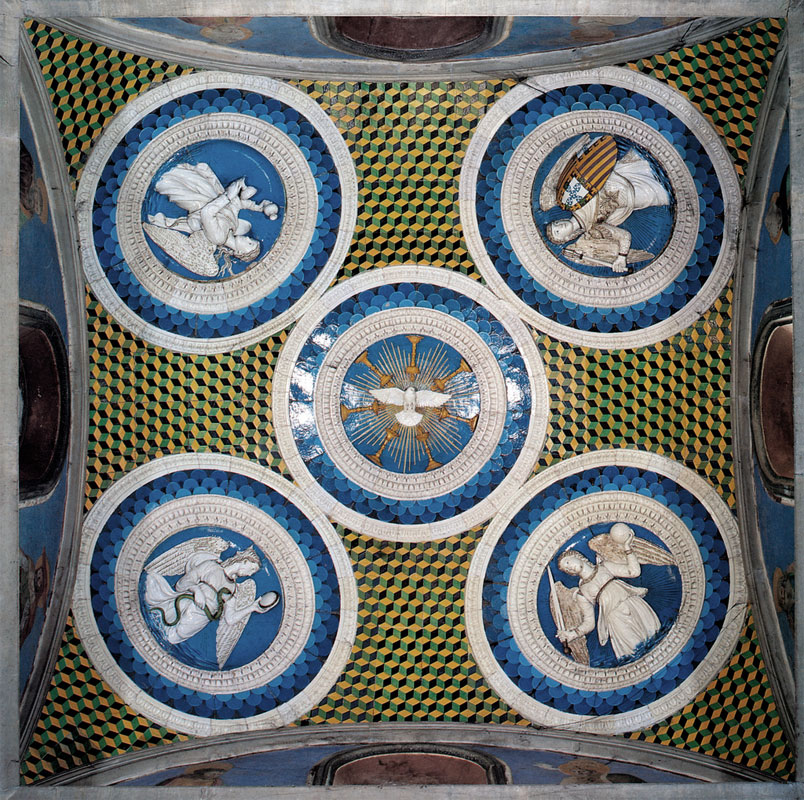Tucked off to one side in the San Miniato al monte church of the Benedictine monastery which overlooks Florence, there is an exquisite renaissance funerary chapel which was added into the fabric of the Romanesque church in the 1400s (it was finished in 1473).
 |
| View of the chapel from the left side aisle of San Miniato al Monte church, Florence |
| Tomb of the cardinal of Lusitania, Antonio Rossellino, 1461-66, white marble and porphyry with traces of polychromy and gold |
 |
| Tomb of Leonardo Bruni, Bernardo Rossellino, 1444-47, marble, Santa Croce church, Florence |
 |
| Altar piece painting of saints Vincent, James and Eustace, Antonio and Piero Pollaiuolo, 1468, tempura on wood, Uffizi gallery, Florence |
Vincent (dressed in his deacon’s robes) because he is the patron saint of Lisbon and patron of the royal house of Portugal, James (depicted with his usual attribute of a pilgrim’s staff and hat) because he is the cardinal’s namesake and patron saint, and finally, Eustace because it was the cardinal’s titular church in Rome. The floor in the painting resembles the floor of the chapel. The different artistic mediums are all in harmony with one another and fit together like pieces of a puzzle, the painting with the carved marble surroundings and the overall architecture.
The floor is similar to the medieval Romanesque pavements, called cosmatesque, seen most often in religious structures (the same design can be seen in the Sistine chapel done at a similar time to this chapel and then shortly afterwards, in the Raphael rooms of the Vatican palace).
 |
| View of the floor in the chapel of the cardinal of Lusitania, cosmatesque style. |
The name, cosmatesque, refers to the family workshop of mosaicists called Cosmati, active in Rome in the twelve and thirteenth century, who specialised in this inlay style. It is opus sectile mosaic which uses different size pieces of stone not opus tessile mosaic where the tessarae are of the same size. The stones used are semi precious such as porphyry and green serpentine with Carrera white marble and when not decorating floors (columns, pulpits of walls for example) coloured glass is often used, glazed terracotta or gold leaf glass.
Finally, the ceiling is a marvellous display of the della Robbia workshop production.
 |
| Ceilinng of the chapel depicting the four cardinal virtues, Luca della Robbia, 1460s, glazed terrracotta. |
Luca della Robbia was the first artisan to take advantage of terracotta and perfect the coloured glazing which made highly pleasing objects for the decoration of domestic domains as well as churches without the cost of marble. The ceiling here is a testament to the skill in moulding and colouring that he produced in his most successful family workshop. The four cardinal virtues are shown in the tondos in the four corners; temperance mixing wine and water, fortitude with her sword and shield bearing the cardinal’s coat of arms, prudence with her mirror and snake and lastly, justice with her scales. In the middle is the dove of the holy spirit surrounded by seven candle stick holders. These could be symbolic of the seven branched candelabrum (menorah), the ancient symbol of Judaism. To Christians, the menorah symbolises divine wisdom and its seven branches stand for the seven planets, the seven virtues, the seven sacraments to name a few of the Christian groupings of seven to which it could be referring. The shades of blue glaze with the white make the scene seem celestial set against the strong geometric pattern of diamond interlay with yellow, green and black.





